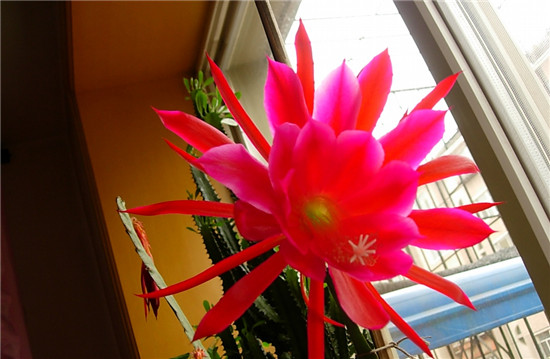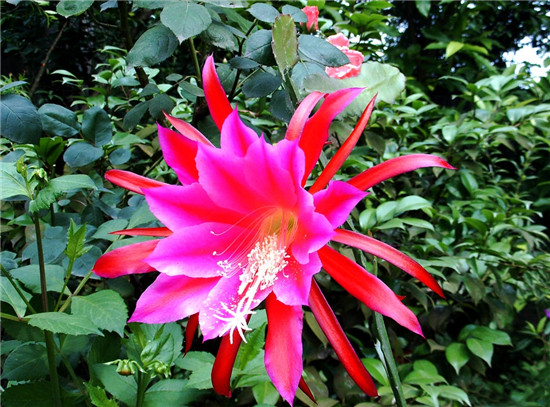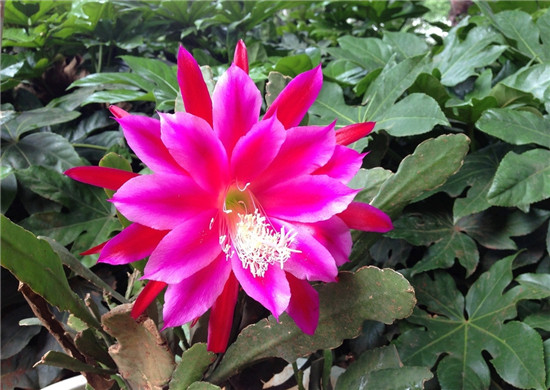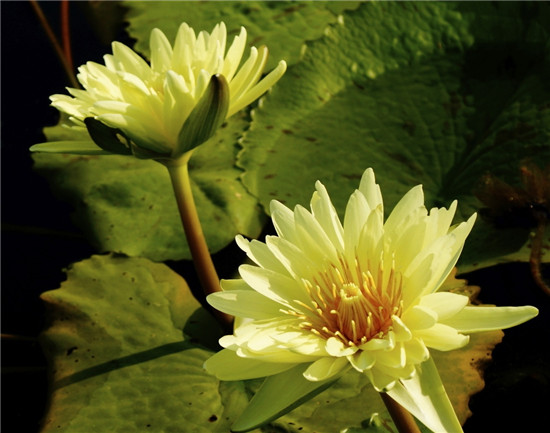[culture method of Ling Arrow Lotus] introduction to the culture method of Ling Arrow Lotus
The arrow lotus is a perennial evergreen epiphyte of the cactus family. Next, we will introduce the breeding methods and matters needing attention of the arrow lotus.

The growth habit of Ling Arrow Lotus
Make the arrow lotus, like the warm and humid environment, avoid direct sunlight, drought, semi-shade, afraid of rain, require fertile, loose, well-drained neutral or slightly acidic sandy loam. The optimum temperature during the growing period is 20-25 ℃, the optimum temperature for flower bud differentiation is 10-15 ℃, the winter temperature should not be lower than 5 ℃, and the florescence is April.
The arrow lotus should be cultivated in loose, fertile and well-drained soil, and it likes fertilizer, and it needs more fertilizer during the growing period so that it can blossom on time and produce beautiful flowers. It is suitable for survival in a warm and humid environment, do not let the balcony direct, drought-resistant and afraid of rain, although like wet, but the soil for planting arrow lotus is required to be a little dry, otherwise it will cause root mildew.

The four Seasons Culture of Lingjian Lotus
Spring
During the growing season, we should pay attention to sufficient light, timely fertilization, and apply nitrogen and phosphorus fertilizer every 10-15 days to promote the healthy growth of flowers and leaves. Avoid stagnant water in the basin to prevent rotting roots. From April, buds appeared at the edge of the fleshy upper half of the leaves, and gradually expanded, and bloomed half a month later. If the plant is undernourished and weakens, it will not blossom or blossom less. In order to prevent this phenomenon, the available phosphate fertilizer can be applied 1-2 times in advance. At the same time, too many lateral buds and basal shoots should be erased.
Summer
During the peak growth period, 1-2 times of nitrogen topdressing should be applied in time. This not only promotes it to grow new branches and leaves, but also helps to grow buds and blossom next spring. If you want to increase the number of stems, it is necessary to seize this favorable period to leave buds. At the height of summer, when the arrow lotus enters the semi-dormant period, it should be placed in a ventilated and cool semi-shade, stop fertilizing, water not too much, and keep the potted soil a little dry to prevent it from being too shady so as not to affect flowering.

Autumn
It is the second peak growth period of the year, the new leaves are gradually aging and mature, and the management and maintenance methods are basically the same as in spring and early summer from May to June. 2-3 times of topdressing can be applied, mainly phosphorus and potash fertilizer. And increase the light time.
Winter
After Frosts Descent, the weather turns cold, need to move into the room to keep warm, can be placed in the sunny place, the room temperature can be kept at 8 ℃. Stop fertilizing, control watering, basin soil is dry, too wet will cause leaf wilting and root rot. From mid-March to early April after spring, the window ventilation exercise time can be gradually extended with the rise of temperature, so as to lay the foundation for moving out of outdoor maintenance in the future.
The breeding method of Ling Arrow Lotus
The arrow lotus is often propagated by cuttings. Because its leafy stem is relatively thick, the incision is very sensitive to soil moisture, the cuttings are easy to rot if they are too wet, and the branches are withered and thin. Even if the cuttings are cut into surviving branches, the original cut is easy to rot in case of continuous rainy days. Therefore, most flower lovers think that family breeding makes arrow lotus more difficult. After years of observation, practice and comparison, the author found that the inverted insertion method can overcome many unfavorable factors and greatly improve the survival rate, and its growth is obviously better than that of the ordinary insertion method.

The specific methods are as follows: the upper end of the stem node with a tip of about 10 meters is buried in the soil, and the depth is about 7 meters. The lower end incision reveals the soil surface, and the root can take root in 20 days, and the new branches can break out in about 40 days. The segment from the new root to the incision naturally atrophied and dried up within 1 year. This method effectively solves the problem that the incision is easy to rot and does not limit the soil moisture. And what is different from the general method of cutting is that the more water and fertilizer the soil is, the more vigorous the cuttings grow, even if the water and fertilizer are controlled, they can grow normally, the branches will not be withered and thin, and the survival rate is more than 90%. From the botanical principle, it can also be reasonably explained: the arrow lotus has no leaves, and the plant respiration is limited, so the tissue at the tip of the abnormal stem and some stem nodes gradually develops into air roots (adventitious roots) to help breathe. Adventitious roots rapidly develop into fixed roots when they encounter soil and water, allowing the plant to survive. The inversion method is successfully tested by using this principle.
Water and fertilizer management
Watering the arrow lotus can be watered every 5 or 6 days in spring and autumn. It is necessary to water less in summer and keep the basin soil semi-dry, especially to avoid stagnant water and rain in the basin, so as to prevent rotting roots caused by too much water. Water can be sprayed around stems and plants in the morning to increase the humidity of the air. Watering should be controlled in winter to keep the basin soil in a slightly wet state. It should be noted that the arrow lotus is afraid of waterlogging. After watering, it is necessary to loosen the soil in time and speed up the evaporation of water. Make the arrow lotus like fertilizer, but not resistant to raw fertilizer and thick fertilizer, can be in its growth period every ten days or so to apply rotten fermented sesame paste residue water. After budding, you can apply some phosphorus and potassium fertilizer, do not apply nitrogen fertilizer, otherwise it will affect flowering. There is generally no fertilization in winter and early spring.
Light and temperature control
In order to make the arrow lotus happy, it should be placed outside the greenhouse in spring and autumn. 50% of the light should be sheltered in summer to avoid direct sunlight at noon. Make it receive more light in the greenhouse in winter. Make the arrow lotus like the warm environment, can not bear low temperature, the humidity in the greenhouse should be kept above 10 ℃ in winter, the temperature is too low, it is easy to suffer frost damage, too high and easy to cause stem overgrowth. Enter the room in mid-October in autumn, and leave the room after Grain Rain in spring.
Pruning and shaping
When pruning and shaping, one is to remove too many branches and buds at the base, so that each pot flower maintains 3 to 4 main stem segments, too many main stems are not conducive to plant modeling. The second is to remove too many new lateral buds on the main stem in time to prevent excessive consumption of nutrients and affect plant bud budding and flowering. In addition, it is also necessary to cap the plant properly, which can make the stem stout, thick and erect.
The above is the whole content of the introduction of the breeding methods of Ling Arrow Lotus for you. I hope this article can help you. Please continue to follow us.
Keep the basin soil semi-dry, especially to avoid stagnant water and rain in the basin, so as to prevent the rotten roots of the plant caused by too much water. Water can be sprayed around stems and plants in the morning to increase the humidity of the air. Watering should be controlled in winter to keep the basin soil in a slightly wet state. It should be noted that the arrow lotus is afraid of waterlogging. After watering, it is necessary to loosen the soil in time and speed up the evaporation of water. Make the arrow lotus like fertilizer, but not resistant to raw fertilizer and thick fertilizer, can be in its growth period every ten days or so to apply rotten fermented sesame paste residue water. After budding, you can apply some phosphorus and potassium fertilizer, do not apply nitrogen fertilizer, otherwise it will affect flowering. There is generally no fertilization in winter and early spring.
Light and temperature control
In order to make the arrow lotus happy, it should be placed outside the greenhouse in spring and autumn. 50% of the light should be sheltered in summer to avoid direct sunlight at noon. Make it receive more light in the greenhouse in winter. Make the arrow lotus like the warm environment, can not bear low temperature, the humidity in the greenhouse should be kept above 10 ℃ in winter, the temperature is too low, it is easy to suffer frost damage, too high and easy to cause stem overgrowth. Enter the room in mid-October in autumn, and leave the room after Grain Rain in spring.
Pruning and shaping
When pruning and shaping, one is to remove too many branches and buds at the base, so that each pot flower maintains 3 to 4 main stem segments, too many main stems are not conducive to plant modeling. The second is to remove too many new lateral buds on the main stem in time to prevent excessive consumption of nutrients and affect plant bud budding and flowering. In addition, it is also necessary to cap the plant properly, which can make the stem stout, thick and erect.
The above is the whole content of the introduction of the breeding methods of Ling Arrow Lotus for you. I hope this article can help you. Please continue to follow us.
Related
- Wuhan Hospital Iron Tree Blooming Result Was Instantly Frightened by the Gardener Master
- Which variety of camellia is the most fragrant and best? Which one do you like best?
- What is the small blue coat, the breeding methods and matters needing attention of the succulent plant
- Dormancy time and maintenance management of succulent plants during dormancy
- Minas succulent how to raise, Minas succulent plant pictures
- What are the varieties of winter succulent plants
- How to raise succulent plants in twelve rolls? let's take a look at some experience of breeding twelve rolls.
- Attention should be paid to water control for succulent plants during dormant period (winter and summer)
- Watering experience of twelve rolls of succulent plants
- Techniques for fertilizing succulent plants. An article will let you know how to fertilize succulent plants.



